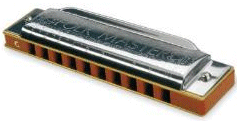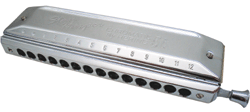

|
Intro to Harmonica |
|||||
“Music in My Pocket” |
|||||
History of the Harmonica |
|||||
|
|||||
Reading Tab |
 |
||||
|
|||||
Reading Notation |
|||||
|
|||||
| Diatonic Harmonica | Chromatic Harmonica | ||||
 |
 |
||||
Parts of a Harmonica |
|||||
| Air Chamber | The hole you blow or draw through | ||||
| Cover Plate | Protective shield for the reeds, also serves as advertising for the manufacturer | ||||
| Comb | Originally made of wood (now plastic) is the skeleton of the harmonica (air chambers) | ||||
| Plunger | A button on the chromatic harmonica allows for 1/2 step pitch change | ||||
| Reeds | Thin pieces of metal, wood or plastic that vibrate to produce the harmonica's sound | ||||
| Reed Plate | A piece of metal which the reeds are attached to | ||||
Introduction to Harmonica Players (Also called Harpists) |
|||||
| Bob Dylan (Folk) |
John Popper (Rock) |
Toots Thielemans (Jazz) |
Marion Little Walter
Jacobs (Blues) |
||
| Stevie Wonder (Pop) |
|||||
Harmonica Call Charts |
|||||
|
Run-Around |
Undecided |
Hoochie Coochie Man | |||
| Fingertips Pt 2 | |||||
| |
|
|
|
||
|
|
|
|
|
||
| |
|
|
|
||
| |
|
|
|
||
| |
|
|
|
||
| |
|
|
|
||
Basic Harmonica Lessons |
|||||
Basic Lessons |
Video/Ipod Lessons |
Songs |
Improvisation Tracks |
||
| Hand Position |
iPod | Q.time | |||
Making a Sound |
iPod | Q.time | |||
Vibrato |
iPod | Q.time | |||
Bending |
iPod | Q.time | |||
| Unit 5 - 8th Notes | The Rip |
iPod | Q.time | ||
| Unit 6 - Song #1 | |||||
| Unit 7 - Song #2 | |||||
| Lesson 8 - Song #3 | |||||
| Lesson 9 - Song #4 | |||||